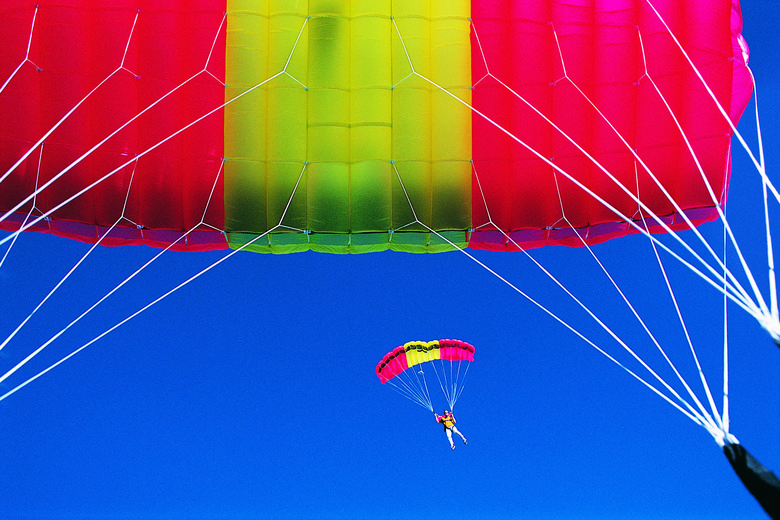The Physical Factors Affecting Parachutes
A parachute is one of the most visual ways to understand the power of gravity and air, and how they can work against each other. A parachute makes the seemingly impossible, such as jumping safely from an airplane, possible. It allows the user to harness the air to control and slow his descent.
Gravity
Gravity
A parachute is a length of light-weight fabric attached to a heavier object, such as a human body. As gravity works to pull the object toward the Earth, the parachute is opened, releasing the fabric that works against the gravity, slowing it down. The parachute, of course, does not stop gravity. The object eventually reaches the ground. The parachute slows it enough that the object lands much more softly than it would without one. Parachutes reduce gravity to the point that a human body can safely fall from an airplane while using one.
Air Resistance
Air Resistance
When a parachute opens, it is a second force that works against gravity. This is air resistance. Air collects under the fabric parachute, pushing it up as gravity pulls the heavy object attached to it down. This pushing slows the fall of the object by resisting the air under the parachute. Air resistance is a non-conservative force, in that the work it does is dependent on the downward motion of the heavy object pulled by gravity toward the Earth.
Terminal Velocity
Terminal Velocity
When a heavy object falls, it reaches a speed called terminal velocity. This is the speed the object will continue to fall unless something stops it. For instance, landing on the ground ends terminal velocity. Opening a parachute changes terminal velocity, making it much slower than the terminal velocity of an object in free fall. The open parachute results in air resistance that is greater than the pull of gravity. Terminal velocity reduces until there is a balance again, which happens at a speed slow enough for the falling object to make a safe landing.
An Experiment
An Experiment
Experiment with gravity, air resistance and terminal velocity by making your own miniature parachute. Punch four equidistant holes around the rim of a paper cup. Tie a length to each of the holes, and attach the other ends to the corners of a parachute cut from a plastic grocery bag. Stand on a ladder and drop the cup. You may need to experiment with the size and shape of the parachute and the lengths of the strings before you can reliably send the cup down without spilling the pennies.
Cite This Article
MLA
Alburger, Shaunta. "The Physical Factors Affecting Parachutes" sciencing.com, https://www.sciencing.com/physical-factors-affecting-parachutes-8713065/. 24 April 2017.
APA
Alburger, Shaunta. (2017, April 24). The Physical Factors Affecting Parachutes. sciencing.com. Retrieved from https://www.sciencing.com/physical-factors-affecting-parachutes-8713065/
Chicago
Alburger, Shaunta. The Physical Factors Affecting Parachutes last modified March 24, 2022. https://www.sciencing.com/physical-factors-affecting-parachutes-8713065/
